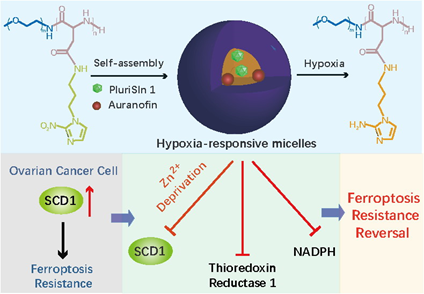Ferroptosis has been recognized as a promising therapeutic strategy for cancer due to its unique mechanism of action. However, the upregulation of stearoyl-CoA desaturase 1 (SCD1) in ovarian cancer leads to resistance to ferroptotic therapy. Zinc ion (Zn2+) serves as the cofactor of SCD1. It was hypothesized that selective deprivation of Zn2+ from SCD1 could sensitize ferroptotic ovarian cancer therapy. Here, we report a hypoxia-responsive polymer micelle for enhanced ferroptosis of ovarian cancer cells. A SCD1 inhibitor, PluriSIn 1 (Plu), and a ferroptosis inducer, Auranofin (Aur), were co-encapsulated in nitroimidazole-bearing micelles. Under the hypoxic tumor microenvironment, the conversion of nitroimidazole to aminoimidazole triggered the cargo release and induced the depletion of antioxidant molecules (e.g., glutathione, thioredoxin, and NADPH). Meanwhile, because of the strong coordination between aminoimidazole and Zn2+ compared to that of histidine and Zn2+, such conversion can deprive the metal cofactor of SCD1, hence sensitizing the action of Plu and Aur. The proof-of-concept was demonstrated in cell and animal models with minimal systemic toxicity. The current work integrates ferroptosis induction with SCD1 inhibition in a hypoxia-responsive vehicle, offering a promising strategy for addressing the ferroptosis resistance and opening novel avenues for managing the difficult-to-treat ovarian cancer.
This work has been published in Biomaterials.
https://www.sciencedirect.com/science/article/pii/S0142961224003545?via%3Dihub


